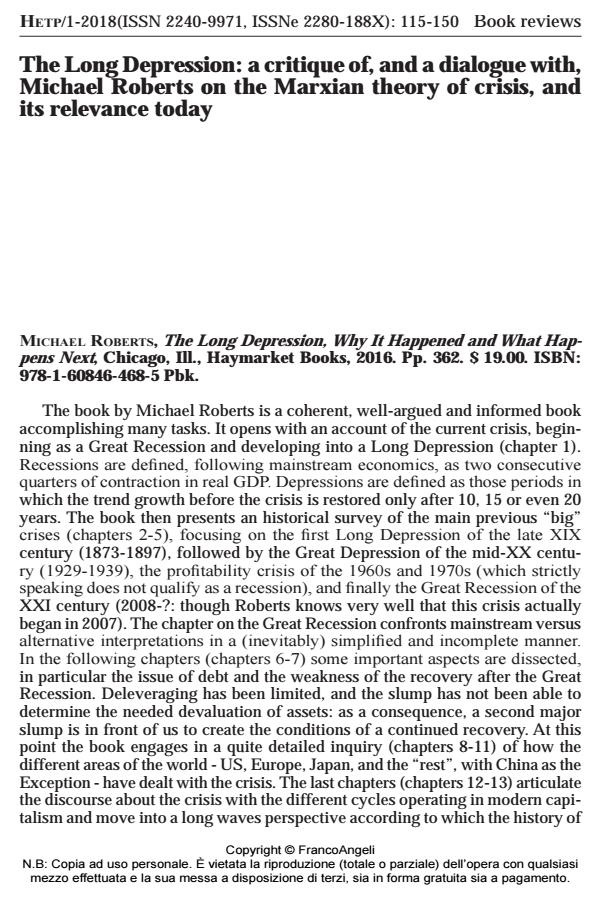Book reviews
Titolo Rivista HISTORY OF ECONOMIC THOUGHT AND POLICY
Autori/Curatori
Anno di pubblicazione 2018 Fascicolo 2018/1 Lingua Inglese
Numero pagine 36 P. 115-150 Dimensione file 334 KB
DOI 10.3280/SPE2018-001006
Il DOI è il codice a barre della proprietà intellettuale: per saperne di più
clicca qui
Qui sotto puoi vedere in anteprima la prima pagina di questo articolo.
Se questo articolo ti interessa, lo puoi acquistare (e scaricare in formato pdf) seguendo le facili indicazioni per acquistare il download credit. Acquista Download Credits per scaricare questo Articolo in formato PDF

FrancoAngeli è membro della Publishers International Linking Association, Inc (PILA)associazione indipendente e non profit per facilitare (attraverso i servizi tecnologici implementati da CrossRef.org) l’accesso degli studiosi ai contenuti digitali nelle pubblicazioni professionali e scientifiche
- Bellofiore R. (2011). Crisis Theory and the Great Recession: A Personal Journey, from Marx to Minsky. In P. Zarembka and R. Desai (eds), Revitalizing Marxist Theory for Today’s Capitalism. Research in Political Economy, 27: 81-120.
- Bellofiore R. (2017). Between Schumpeter and Keynes: The Heterodoxy of Paul Marlor Sweezy and the orthodoxy of Paul Mattick, Capital 150 Years Later, Continental Theory and Thought: A Journal of Intellectual Freedom, 1(4): 72-111, online -- https://ir.canterbury.ac.nz/bitstream/handle/10092/14487/6%20Bellofiore%20Capital.pdf?sequence=1&isAllowed=y.
- Bellofiore R. and G. Vertova (2014). The Great Recession and the contradictions of contemporary capitalism, Cheltenham, Edward Elgar.
- Fine B. and L. Harris (1976). Controversial Issues in Marxist Economic Theory, Socialist Register 1976, ed. R. Miliband and J. Saville, London, Merlin Press: 141-78.
- Heinrich M. (2013). Crisis Theory, the Law of the Tendency of the Profit Rate to Fall, and Marx’s Studies in the 1870s, Monthly Review, 64(11): 15-31
- Mattick P. sr. (1969). Marx and Keynes: The Limits of the Mixed Economy, London, Merlin Press.
- Mattick P. jr. (2017). Marx’s Abstraction and Contemporary Capitalism, presented at Marx 150: Marx’s Capital today, London King’s College (19-20 September), mimeo.
- Reuten G. (2004). “Zirkel vicieux” or Trend Fall? The Course of the Profit Rate in Marx’s Capital III, History of Political Economy, 36(1): 163-186.
- Saad Filho A. (2002). The Value of Marx: Political Economy for Contemporary Capitalism, London, Routledge.
- Barbero A. (2003). La guerra in Europa dal Rinascimento a Napoleone, Rome, Carocci.
- Barone F. (1958). 1748: viaggio di Hume a Torino, Cuneo, Edizioni Filosofia, S. A. S. T. E.
- Daunton, M.J. (1995). Progress and Poverty: An Economic and Social History of Britain 1700-1850, Oxford, Oxford University Press.
- Floud R. and P. Johnson (2004). The Cambridge Economic History of Modern Britain, Industrialisation, 1700 - 1860, vol. I, Cambridge, Cambridge University Press.
- Freedman L. (2013). Strategy: a History, Oxford, Oxford University Press.
- McLynn F.J. (1983). Jacobitism and David Hume: The Ideological Backslash, Hume Studies, 9(2): 171-199.
- Sankey M. and D. Szechi (2001). Elite Culture and the Decline of Scottish Jacobitism 1716–1745, Past & Present, 173(1): 90-128.
- Steven-Cox G. (2009). The Guernsey Merchants and Their World in the Georgian Era, Guernsey, Toucan Press.
- Trevor-Roper H. (1993). The invention of Tradition: the Highland Tradition of Scotland. In Hobsbawm E. J. and Ranger T.O. (eds), The Invention of Tradition, Cambridge, Cambridge University Press.
, Book reviews in "HISTORY OF ECONOMIC THOUGHT AND POLICY" 1/2018, pp 115-150, DOI: 10.3280/SPE2018-001006